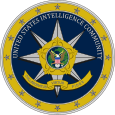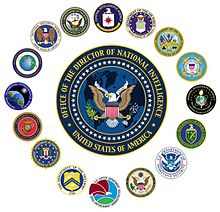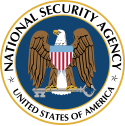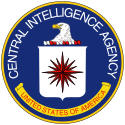USA's efterretningsfællesskab
| USA's efterretningsfællesskab | |||||
|---|---|---|---|---|---|
| |||||
| Overblik | |||||
| Etableret | 4. december 1981 | ||||
| Ledelse | |||||
| Direktør (DNI) | Avril Haines | ||||
| Eksterne henvisninger | |||||
| Myndighedens hjemmeside | |||||
USA's efterretningsfællesskab (engelsk: United States Intelligence Community eller ofte blot omtalt IC), er en gruppe af føderale efterretningstjenester og underordnede organisationer, der arbejder både separat og kollektivt for at udføre efterretningsaktiviteter, der understøtter USA's udenrigspolitiske og sikkerhedsinteresser. USA's efterretningsfællesskab omfatter efterretningstjenester, militær efterretningstjeneste og civile efterretnings- og analysekontorer inden for USA's føderale regering (en del af den udøvende magt). USA's efterretningsfællesskab administreres af Office of the Director of National Intelligence (ODNI), der ledes af Director of National Intelligence (DNI), som rapporterer direkte til USA's præsident.[1][2]
USA's efterretningsfællesskab blev etableret gennem præsidentielt dekret nummer 12333 ("United States Intelligence Activities"), underskrevet den 4. december 1981 af præsident Ronald Reagan.[3] Den lovpligtige definition af USA's efterretningsfællesskab, herunder dets liste over (underordnede) agenturer, blev kodificeret i Intelligence Organization Act of 1992. [4]
Washington Post rapporterede i 2010, at der var 1.271 statslige organisationer og 1.931 private virksomheder fordelt på 10.000 lokationer i USA, der arbejdede med terrorbekæmpelse, nationalsikkerhed og efterretningstjeneste, og at USA's efterretningsfællesskabet som helhed omfattede 854.000 mennesker med tophemmelige sikkerhedsgodkendelse.[5] Ifølge en ODNI-undersøgelse fra 2008 udgjorde private entreprenører 29% af arbejdsstyrken i USA's efterretningsfællesskab og tegner sig for 49% af deres personalebudgetter.[6]
Historie
Efter vedtagelsen af Intelligence Reform and Terrorism Prevention Act i 2004 blev rollen som Director of National Intelligence (DNI) oprettet og gjort til leder af USA's efterretningsfællesskab (IC). DNI's primære ansvarsområder blev bestemt til at omfatte:[7][8]
- udvikler og eksekverer det nationale efterretningsprograms budget;
- fastlægger mål, prioriteter og vejledning for IC; og
- administrerer og lede opgaven med indsamling, analyse, produktion og formidling af national efterretning fra elementer af IC.
Selvom IC karakteriserer sig selv som en føderation mellem sine forskellige medlemsagenturer,[9] er dens overordnede struktur bedre karakteriseret som en konføderation på grund af dens mangel på en veldefineret og samlet ledelsesstruktur. Før 2004 var Director of Central Intelligence (DCI) leder af IC, foruden også at være direktør for CIA. Et væsentligt kritikpunkt af denne struktur var, at DCI havde ringe eller ingen egentlig myndighed og indflydelse over budgetrammerne i de andre IC-agenturer og derfor også havde begrænset indflydelse på deres operationer.
Til trods for sine forpligtelser har DNI ingen beføjelse til at lede og kontrollere nogle andre element af IC end DNI's eget personale (ODNI). DNI har således heller ikke beføjelse til at ansætte eller fyre personale i de forskellige underordnede medlemsagenturer – DNI har kun beføjelser til ansætte og fyre personale i ODNI. De enkelte medlemsagenturer er underlagt deres respektive moderorganisation, herunder deres respektive føderale ministerium/afdeling. I henhold til loven er det kun CIA-direktøren, der rapporterer til DNI.[10][11]
I lyset af større efterretningsfejl i begyndelsen af 2000'erne, der satte spørgsmålstegn ved, hvor godt efterretningssamfundet sikrede USA's nationale sikkerhed – især problemer identificeret i forbindelse med 9/11-kommissionen (National Commission on Terrorist Attacks Upon the United States) og WMD-kommissionen (Commission on the Intelligence Capabilities of the United States Regarding Weapons of Mass Destruction). DNI's myndigheder og beføjelser, herunder den overordnede organisatoriske struktur af IC, har som følge heraf været genstand for intens debat i USA.
Liste over medlemsagenturer
| Segl | Organisation | Moderorganisation | Føderal afdeling | Dato est. |
|---|---|---|---|---|
| Office of Naval Intelligence (ONI) | U.S. Navy | Forsvarsministerium | 1882 | |
 | Coast Guard Intelligence (CGI) | U.S. Coast Guard | Hjemmeværn | 1915 |
 | Bureau of Intelligence and Research (INR) | Udenrigsministeriet | Udenrigsministeriet | 1945 |
 | Central Intelligence Agency (CIA) | Ingen | Uafhængigt bureau | 1947 |
| Sixteenth Air Force (16 AF) (USAF ISR Enterprise) | U.S. Air Force | Forsvarsministerium | 1948 | |
  | National Security Agency (NSA) / Central Security Service (CSS) [Note 1] | Forsvarsministerium | Forsvarsministerium | 1952 |
 | National Reconnaissance Office (NRO) | Forsvarsministerium | Forsvarsministerium | 1961 |
 | Defense Intelligence Agency (DIA) | Forsvarsministerium | Forsvarsministerium | 1961 |
 | Military Intelligence Corps (MIC) | U.S. Army | Forsvarsministerium | 1977 |
 | Office of Intelligence and Counter Intelligence (OICI) | Energiministeriet | Energiministeriet | 1977 |
 | Marine Corps Intelligence (MCI) | U.S. Marine Corps | Forsvarsministerium | 1978 |
 | National Geospatial-Intelligence Agency (NGA) | USA's forsvarsministerium | Forsvarsministerium | 1996 |
 | Office of Intelligence and Analysis (OIA) | Finansministeriet | Finansministeriet | 2004 |
 | Intelligence Branch (IB) | Federal Bureau of Investigation (FBI) | Justitsministeriet | 2005 |
 | Office of National Security Intelligence (ONSI) | Drug Enforcement Administration | Justitsministeriet | 2006 |
 | Office of Intelligence and Analysis (I&A) | U.S. Department of Homeland Security | Hjemmeværn | 2007 |
 | National Space Intelligence Center (NSIC) (USSF ISR Enterprise) | U.S. Space Force | Forsvarsministerium | 2020 |
Noter
- ^ NSA's centrale sikkerhedstjeneste inkluderer også den amerikanske flådes flådecyberkommando og, marinekorpsets kryptologiske støttebataljon.
Referencer
- ^ Agrawal, Nina. "There's more than the CIA and FBI: The 17 agencies that make up the U.S. intelligence community". Los Angeles Times. Hentet 30. januar 2017.
- ^ "Members of the IC" (amerikansk engelsk). Office of the Director of National Intelligence. Arkiveret fra originalen 17. november 2018. Hentet 17. november 2018.
- ^ "Executive Order 12333". Cia.gov. Arkiveret fra originalen 12. juni 2007. Hentet 23. januar 2013.
- ^ "In Focus: U.S. Intelligence Community Elements: Establishment Provisions". Congressional Research Service.
- ^ Dana Priest; William M Arkin (19. juli 2010). "A hidden world, growing beyond control". The Washington Post. Arkiveret fra originalen 20. juli 2010.
- ^ Priest, Dana (2011). Top secret America : the rise of the new American security state. William M. Arkin (1st udgave). New York: Little, Brown and Co. s. 320. ISBN 978-0-316-18221-8. OCLC 707964997.
- ^ "The National Counterintelligence and Security Center: About". Office of the Director of National Intelligence. Hentet 23. november 2020.
- ^ "U.S. National Intelligence: An Overview, 2013" (PDF). dni.gov. Hentet 23. november 2020.
- ^ "What is Intelligence?". www.odni.gov (britisk engelsk). Office of the Director of National Intelligence. Arkiveret fra originalen 17. november 2018. Hentet 17. november 2018.
- ^ "In today's intelligence hierarchy, who really runs the show? - CNN.com". www.cnn.com. Hentet 29. august 2021.
- ^ "The Role of the Director of National Intelligence as 'Head' of the Intelligence Community - Foreign Policy Research Institute". www.fpri.org. Hentet 29. august 2021.
Yderligere læsning
- Foreign Relations of the United States by the Office of the Historian of the United States Department of State:
- 1945–1950, Emergence of the Intelligence Establishment. Thorne, Jr., C. T. & Patterson, D. S. (Eds.) 1996. ISBN 0-16-045208-2. OCLC 35167352.
- 1950–1955, The Intelligence Community, 1950–1955. Keane, D. & Warner, M. (Eds.) 2007. ISBN 0-16-076468-8. OCLC 216660202.
- Richelson, Jeffrey T. (2012). The United States Intelligence Community (Sixth udgave). Boulder, Colo.: Westview Press. ISBN 978-0-8133-4512-3. OCLC 701015423. (Webside ikke længere tilgængelig)
|
Medier brugt på denne side
Flag of the U.S. Intelligence Community.
Seal of the United States Department of Homeland Security. A graphically styled American eagle appears in a circular blue field. The eagle's outstretched wings break through an inner red ring into an outer white ring that contains a circular placement of the words "U.S. DEPARTMENT OF" in the top half and "HOMELAND SECURITY" in the bottom half. The outer white ring has a silvery gray border. As in The Great Seal, the eagle’s left claw holds an olive branch with 13 leaves and 13 seeds while the right claw grasps 13 arrows. Centered on the eagle's breast is a shield divided into three sections containing elements that represent the homeland "from sea to shining sea." The top element, a dark blue sky, contains 22 stars representing the original 22 agencies and bureaus that have come together to form the department. The left shield element contains white mountains behind a green plain underneath a light blue sky. The right shield element contains four wave shapes representing the oceans, lakes and waterways alternating light and dark blue separated by white lines.
Space Delta 18 emblem
Seal of the Defense Intelligence Agency (DIA).
USMC Intelligence Department Seal
Forfatter/Opretter: SuperWIKI, Licens: CC BY-SA 4.0
This is an SVG version of the seal of the United States Army Military Intelligence Corps, self-published by me. The original version was created by the United States Army Institute of Heraldry and is in the public domain as a production of the United States Army.
Seal of the Office of Naval Intelligence.
The seal of the U.S. National Security Agency. The first use was in September 1966, replacing an older seal which was used briefly. For more information, see here and here.
Seal of the USIC as of 2008
Seal of the United States Drug Enforcement Administration
New (2008) seal of the United States National Geospatial-Intelligence Agency. This new version is the same as the previous version except it has a different inscription. For more information, see here.
This resembles the 17 IC-related agencies within the executive branch of the United States Government (USG). The U.S. Intelligence Community (IC) consists of 16 agencies and organizations under the Office of the Director of National Intelligence that all collaborate with the U.S. Justice Department.
Seal of the United States Coast Guard Intelligence
The seal of the United States Department of the Treasury.
The original seal dates from the Board of Treasury during the Articles of Confederation, and so predates the department (and Federal Government) itself. The current design is a slight simplification of the original, introduced in 1968.
The seal's arms depicts balancing scales (to represent justice), a key (the emblem of official authority) and a chevron with thirteen stars (to represent the original states).
For more information, see here.Seal of the C.I.A. - Central Intelligence Agency of the United States Government.
FBI Intelligence Branch seal
Seal of the United States Central Security Service, part of the National Security Agency. The seal dates from 1996. The five-pointed gold mullet is a symbol of ideologies representing the services' common beliefs. Between each point of the mullet is a symbol of the four cryptologic service elements and the American eagle as blazoned on the NSA emblem. The emblems appear in the following order from the upper right: United States Marine Corps; Army Intelligence and Security Command; National Security Agency; Air Intelligence Agency; and the Naval Security Group. Each are equally balanced around a five point star on which is centered the symbol of NSA/CSS, who "provides the funding, direction, and guidance to all of America's SIGINT activities". For more information, see here. The blue background of the CSS emblem represents fidelity and steadfastness.























